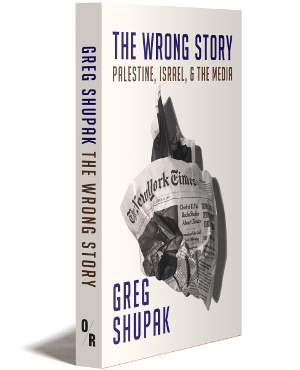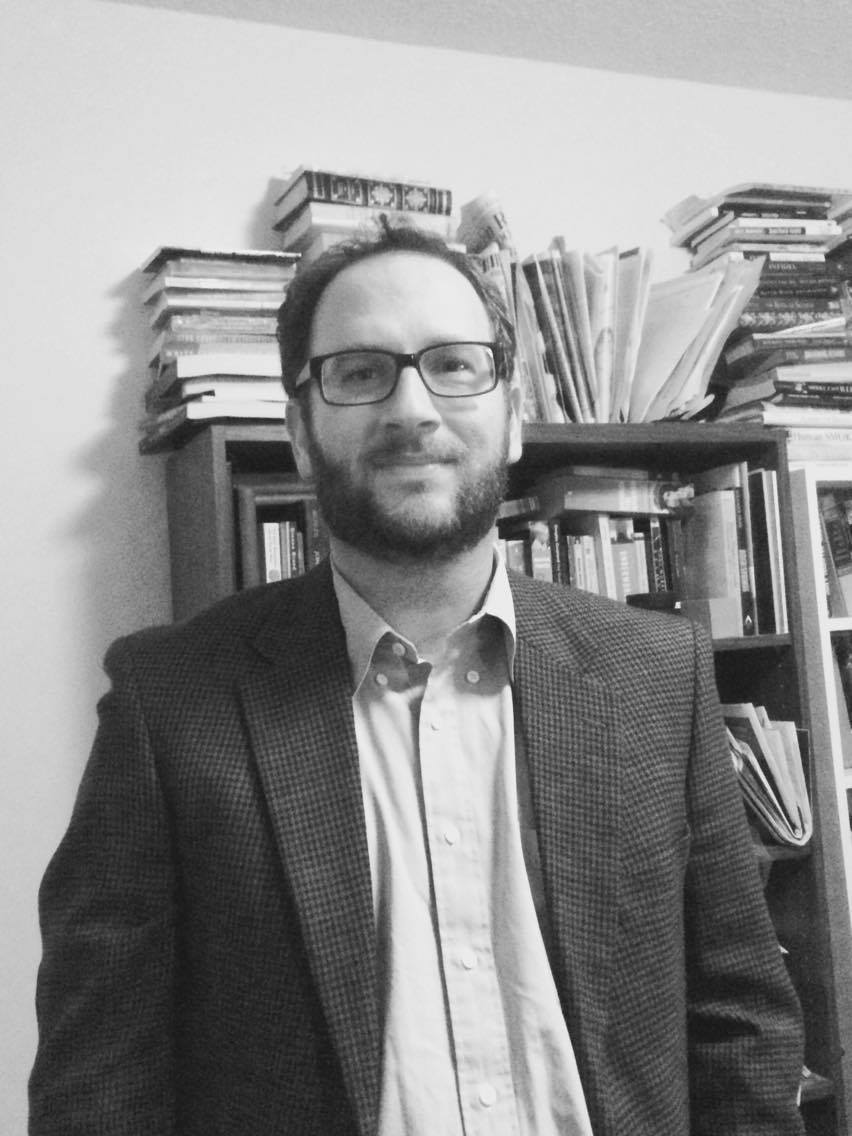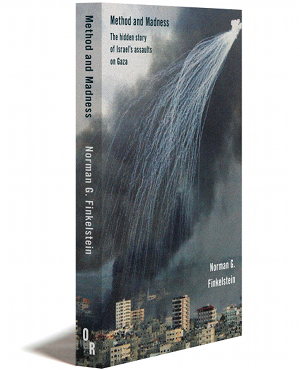
The Wrong Story
PALESTINE, ISRAEL, AND THE MEDIA
“In the face of all of the trash that continues to pass for news and analysis of the Palestine-Israel conflict, Shupak deserves immense praise for working to set the record straight.”
—Middle East Eye
Tweet
About the Book
The Wrong Story lays bare the flaws in the way large media organizations present the Palestine–Israel issue. It points out major fallacies in the fundamental conceptions that underpin their coverage, namely that Palestinians and Israelis are both victims to comparable extents and are equally responsible for the failure to find a solution; that the problem is “extremists,” often religiously-motivated ones, who need to be sidelined in favour of “moderates”; and that Israel’s uses of force are typically justifiable acts of self-defense.
Weaving together the existing literature with new insights, Shupak offers an up-to-date and tightly focused guide that exposes the distorted way these issues are presented and why each is misguided.
195 pages • Paperback ISBN 978-1-682191-28-6 • E-book 978-1-682191-29-3
About the Author
 |
Greg Shupak has a PhD in Literary Studies and teaches Media Studies at the University of Guelph in Toronto. His fiction has appeared in a wide range of literary journals and he regularly writes analysis of politics and media for a variety of outlets including Electronic Intifada, In These Times, Jacobin, Literary Review of Canada, Middle East Eye, TeleSUR, This Magazine, and Warscapes. |
Advance Praise
“By refusing the ‘both sides’ narrative Greg Shupak reminds the reader of the asymmetrical relation between the colonizer and the colonized … Distortions, falsifications and omissions, the author asserts, have largely been characteristic of existing media. I highly recommend this book for media students and experts.” —Nahla Abdo, author, Captive Revolution
“In The Wrong Story, Gregory Shupak powerfully dismantles the mainstream English-language press’ deeply problematic—and false—narrative about Palestine … Give this book both to those interested in learning (or unlearning) about Palestine, and to those eager to learn about deconstructing the media’s lies and, unfortunately, all too often the false framing of the so-called human rights organizations.”
—Rania Masri
“Shupak’s The Wrong Story is a crisply written yet formidable analysis of some of the key tropes underlying media narratives surrounding Palestine–Israel. Neatly organized around the New York Times’ coverage of Israel’s attacks against the Gaza Strip in 2014, the book powerfully reveals the hidden histories of colonization, dispossession, and occupation. A searing indictment of how the corporate media frames Israeli state policy—and a much needed corrective for all those interested in really understanding the ongoing injustice against the Palestinian people.” —Adam Hanieh, author Capitalism and Class in the Gulf Arab States
“The unrelenting, decades-long pattern of biased media coverage of the Israel/Palestine conflict has had deadly consequences for the Palestinians. Seeing through it requires rigorous study and careful thinking. In The Wrong Story, Greg Shupak demonstrates not only how and why the media are so awful on this issue, but also what coverage of Israel/Palestine reveals about media frames and biases more generally. The result is an invaluable short course on the media.” —Justin Podur, Professor, York University; author, Haiti’s New Dictatorship
“A powerful and insightful analysis that confronts, challenges and exposes the systematically deceptive frameworks and narratives in English-language mainstream media regarding Palestine and the Palestinian people. Shupak’s careful and precise work lays bare the colonial realities that are routinely evaded by major corporate and official media. It is a necessary tool for researchers, activists, students and all media consumers who wish to understand the reality of occupation, colonization and apartheid in Palestine.” —Charlotte Kates, International Coordinator, Samidoun Palestinian Prisoner Solidarity Network
“In the tradition of Norman Finkelstein’s work, Shupak uses evidence to challenge three dominant narratives presented by the mainstream media about the Israeli-Palestinian conflict. He guides readers through media misrepresentation in order to grasp the complex reality of two unequal parties in a situation of occupation. Drawing on the events of 2014, but also the broader context of the conflict, this book is a great teaching tool about the Israeli occupation of Palestine for university students as well as general audiences.” —Dr. Angela Joya, Department of International Studies, University of Oregon
“Greg Shupak’s book is a nuanced, engaging and accessible deconstruction of the often distorted media narratives around Palestine/Israel. He compels the reader to see beyond simplistic headlines and overly rehearsed soundbites. This is a very welcome and timely intervention.” —Rafeef Ziadah, University of London, author and performer of We Teach Life
“In his judicious study of corporate media narratives on the Israel-Palestine conflict, Gregory Shupak uncovers and debunks the misleading tropes that have allowed Israel to maintain its military and expansionist policies. Shupak not only deconstructs the media narratives that perpetuate Israel’s illegal and oppressive practices, but links these narratives to the political economy of global capitalism under American hegemony. With a careful and insightful analysis of comparative evidence, Shupak succeeds in recasting the conflict in ways that point towards liberation for all parties interested in peace and justice.” —Jerome Klassen, University of Massachusetts Boston
Read an Excerpt
From the Introduction
In each chapter of this book, I demonstrate that the narrative under consideration is both widespread and distorted. Each one misleads, furthermore, in a manner favorable to Israel. The “both sides” narrative identifies a small portion of the injustice done to Palestinians while proportionately inflating the harm done to Israelis. This perspective, moreover, advances a false equivalency between the rights and responsibilities of the colonizers and the colonized. Framing Palestine-Israel in terms of “extremists and moderates” diagnoses the problem of ongoing violence as being a result of Palestinian terrorists and in some cases a fringe of hardline Israelis. Such a view implies that Palestinians resistant to US-Israeli prerogatives are dangerous fanatics as are Israel’s settlers and far right and prescribes the solution of isolating Palestinians who are unwilling to accommodate US-Israeli designs and empowering more pliable Palestinians. This narrative also suggests that the right wing fringes of the Israeli polity are deviations from an otherwise civilized society who can be brought under control by the majority of the country’s ruling class, which is allegedly democratic and peace-seeking. The story of “Israel defending itself ” supposes that the question of Palestine is unresolved because of Palestinian attacks, judges Palestinian militants’ engagement in armed conflict to be unjustified and Israel’s involvement to be justified, and advocates solutions characterized by Palestinian surrender and Israeli dominance.
Narratives such as these emerge when an issue is repeatedly covered using the same media frame. “To frame,” according to Robert Entman, “is to select some aspects of a perceived reality and make them more salient in a communicating text, in such a way as to promote a particular problem definition, causal interpretation, moral evaluation, and/or treatment recommendation for the item described. Typically frames diagnose, evaluate, and prescribe.” Through these processes, the media send messages about the nature of socio-political problems, their causes, who bears responsibility for them, how conflicts can be resolved, and which parties must take which actions for that to happen. Joseph N. Cappella and Kathleen Hall Jamieson write that “news frames are those rhetorical and stylistic choices, reliably identified in news” which have the capacity to “alter the interpretations of the topics treated and are a consistent part of the news environment.” By taking these approaches, media outlets construct overarching stories about the subject in question.
The stories told about Palestine-Israel are as notable for what they exclude as they are for what they include. Narrative frames, as Entman points out, “are defined by what they omit as well as include, and the omissions of potential problem definitions, explanations, evaluations, and recommendations may be as critical as the inclusions in guiding the audience.”
The frames through which stories are presented direct audiences toward specific understandings of issues by highlighting some details at the expense of the others and emphasizing particular contexts while obscuring others. Presenting Palestine-Israel as a conflict in which “both sides” have wronged and been wronged to comparable degrees means burying such matters as, for example, the 1948 Nakba in which Palestinians were ethnically cleansed in order to create the Israeli state. When the Palestine-Israel question is described as a story about violent “extremists” who have prevented a solution from taking hold, this account necessarily leaves out the ways that peace has been undermined by the systemic economic and geo-political forces that drive Israeli colonization and the American role in enabling that colonization. A narrative that emphasizes “Israel’s right to defend itself ” requires leaving out the Palestinians’ right to 4 defend themselves as well as the persistent pattern of Israel initiating fighting and killing where more Palestinians are killed by Israelis by an order of magnitude.
Nothing in this book should be taken to suggest that audiences consist entirely of dupes who uncritically accept whatever the media says. People can and do think critically about the media they consume. Yet when media outlets misrepresent issues, they hamper the public’s capacity to systematically understand the topics of the day. Ideally, the news media would present the public with easily accessible, comprehensive depictions of the world that people can draw on during the often short periods available to them to learn about political affairs in their daily lives. This, however, is far from the case. Viewers, readers, and listeners who approach news media with skeptical attitudes may have a general sense that they are being presented with skewed perspective. However, absent readily available and more precise information, skepticism does not necessarily translate into a clearer grasp of the issues being covered.
The stories presented in news media are not disseminated in a vacuum and it is necessary to understand that they are circulated in specific cultural contexts. According to Faiza Hirji, ruling class techniques for securing ideological hegemony “only work when they are affirming beliefs that are already held by media viewers or readers.” A multitude of factors shape those political views such as one’s class position, gender, racial identity, educational background, or the national or cultural groups to which they belong. While news media is not the only source that influences ideology, it is undoubtedly an important source: consumption of a media text can craft the conceptual frames that will then be applied to future acts of media consumption. Similarly, Capella and Jamieson contend that: “Frames not only make the interpretations possible but they also alter the kinds of inferences made. The inferences derive from well-established knowledge structures held by the audience and cued by the messages read or watched.”
In the West, narratives about Palestine-Israel activate the “well established knowledge structures” that exist in a broader cultural context that is colonial, imperialist, Orientalist, or some combination of these, wherein Israel is widely regarded as an outpost of Western civilization in a struggle with backward, savage Arabs. “Frames,” Capella and Jamieson argue, “may be able to activate knowledge, stimulate stocks of cultural mores and values, and create contexts within which what are typically called media effects are produced.” In the case of Palestine-Israel, the stories that are told register in an ideological climate that is deeply Islamophobic, anti-Arab, and permeated by fears of terror attacks.
This book pays close attention to The New York Times’ summer 2014 editorials on Israel’s Operation Protective Edge. Focusing on that newspaper is warranted because it is perhaps the most influential print media source in the United States, if not the entire English-speaking world. Because most of the media articles that I examine are from 2014, I have tried to the greatest extent possible to evaluate them with sources published before the commentary being discussed. Using this approach means that important contexts that are left out of the media narratives I consider were readily available to their au-thors when they wrote the articles in question. This book also looks at analysis from other publications, as well as writing on other recent events in Palestine-Israel, so as to demonstrate that the narratives I am assessing are widespread and not confined to the New York Times or to the summer of 2014.
By chronicling the flaws of news media narratives about Palestine-Israel, I hope that this text will contribute to undoing some of the widespread misapprehensions about the issue. My aim is for readers to see that the story of Palestine-Israel is not one of two sides who have wronged each other to comparable extents, or of a question that can be solved by isolating an extremist fringe and empowering moderates, or of an Israeli state defending itself that perhaps sometimes goes too far. I will consider this book a success to the extent that it encourages readers to reject these narratives and instead regard Palestine-Israel as what Nahla Abdo describes as a story of:
…two asymmetrical entities; one is colonizer and occupier and the other is colonized and occupied; one is a regional military superpower and the other is a largely demilitarized entity; one is independent with almost unlimited financial aid from the West …and the other is heavily dependent for its breathing, drinking and feeding, on the air, water, and land that Israel [controls]….In this relationship of occupier and occupied, this asymmetrical relation between those who order and practice the destruction, and those who receive its wrath, one cannot equate between the victim and the victimizer, let alone, blame the victim for the violence.
In the Media
- “The political and economic assault on Iran, as well as any military attack against it, should one materialize, is not only a war for Iran’s future. It is a war for the entire region.” —Greg Shupak, author of THE WRONG STORY (6/14/2019)
- “ What Israel subjects Palestinians to is permanent violence” —Greg Shupak, author of THE WRONG STORY in an interview for The Ossington Circle (6/6/2019)
- “My point is that the problems with the media are institutional and this goes far beyond their misrepresentation of Palestine-Israel.” — Greg Shupak, author of THE WRONG STORY during an interview for Black Agenda Report (5/25/2019)
- GREG SHUPAK discusses THE WRONG STORY: PALESTINE, ISRAEL, AND THE MEDIA at Unauthorized Disclosure (12/6/2018)
- “A fake “balance” between Palestinians and Israelis is a “balance” that favors Israel.” – GREG SHUPAK writing in FAIR (10/25/2018)
- GREG SHUPAK discusses THE WRONG STORY: PALESTINE, ISRAEL, AND THE MEDIA on By Any Means Necessary (10/15/2018)
- “An accurate telling of the Israel-Palestine conflict would tell of Israel violently colonizing Palestine with US support.”- read an excerpt from THE WRONG STORY in Jacobin (10/1/2018)
- “An incisive and in many ways groundbreaking critique of the dominant media narrative.” – THE WRONG STORY reviewed in The Electronic Intifada (7/30/2018)
- “Israeli “self-defense” against Palestinians is logically impossible.” – read an excerpt from THE WRONG STORY at The Electronic Intifada (7/26/2018)
- GREG SHUPAK on the closure of the Gaza-Egypt border at Gorilla Radio (7/17/2018)
- GREG SHUPAK discusses mainstream media coverage of Israel’s oppression of the Palestinians on People’s Republic (6/20/2018)
- “There’s real support for a binational state in Israel, the West Bank and Gaza. You wouldn’t know it from the media” – GREG SHUPAK in Salon (6/5/2018)
- How the media denies Palestinians their humanity – GREG SHUPAK in Middle East Eye (5/31/2018)
- Media Tells Wrong Story About Palestine – GREG SHUPAK interviewed at Talk Nation Radio (5/30/2018)
- “Greg Shupak’s book resonates with clarity” – THE WRONG STORY reviewed in Middle East Monitor (5/28/2018)
- What’s happening in Gaza? – GREG SHUPAK interviewed at A Correction podcast (5/24/2018)
- “For seventy years, Israeli violence has permeated every aspect of Palestinians’ lives” – GREG SHUPAK writes for Jacobin (5/15/2018)
- “Highly relevant and necessary” – THE WRONG STORY: PALESTINE, ISRAEL, & THE MEDIA reviewed at The New Arab (5/2/2018)
- GREG SHUPAK, author of THE WRONG STORY on the media’s bizarre focus on Palestinian ‘violence’ at FAIR (5/1/2018)
- “The US is not at all interested in the welfare of the Syrian people ”: GREG SHUPAK interviewed at FAIR Counterspin (4/26/2018)
- GREG SHUPAK, author of THE WRONG STORY discusses US military intervention in Syria at FAIR Counterspin (4/23/2018)
- Media’s Linguistic Gymnastics Mislead on Gaza Protests – GREG SHUPAK in FAIR (4/17/2018)
- GREG SHUPAK in Jacobin on Trump’s announcement that the United States would recognize Jerusalem as the capital of Israel (12/14/2017)





